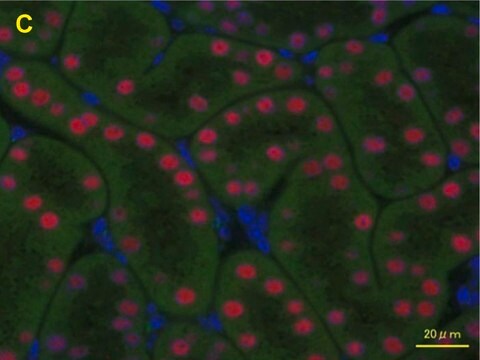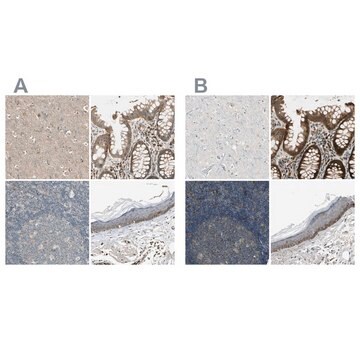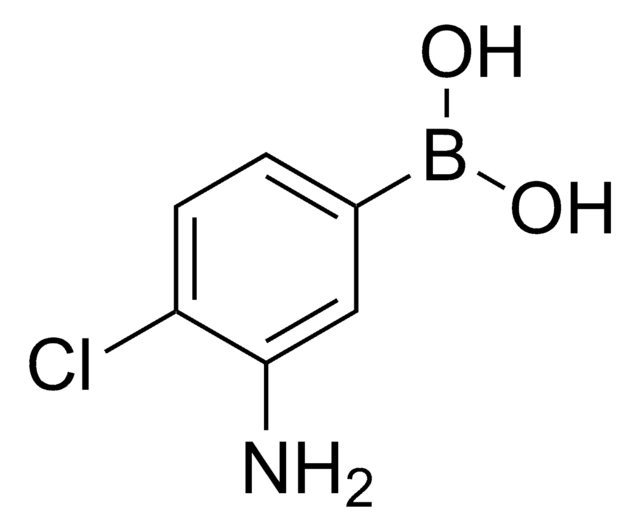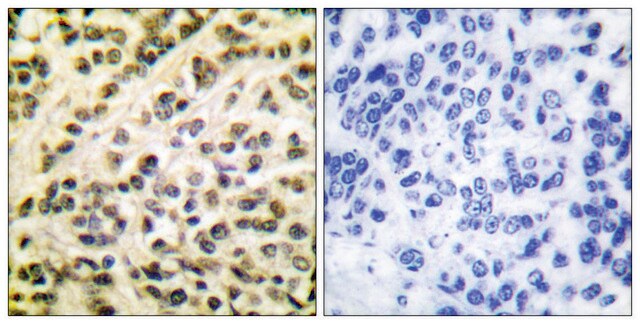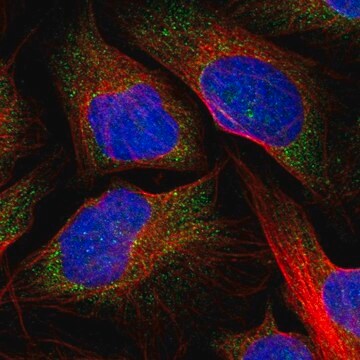HPA010087
抗-GNA13 兔抗
Prestige Antibodies® Powered by Atlas Antibodies, affinity isolated antibody, buffered aqueous glycerol solution
别名:
Anti-G13, Anti-KIAA1063, Anti-MENTHO, Anti-MGC3251, Anti-MGC46138, Anti-USP3L, Anti-guanine nucleotide binding protein (G protein), α 13
登录查看公司和协议定价
所有图片(3)
About This Item
推荐产品
生物源
rabbit
品質等級
共軛
unconjugated
抗體表格
affinity isolated antibody
抗體產品種類
primary antibodies
無性繁殖
polyclonal
產品線
Prestige Antibodies® Powered by Atlas Antibodies
形狀
buffered aqueous glycerol solution
物種活性
human
技術
immunofluorescence: 0.25-2 μg/mL
immunohistochemistry: 1:50-1:200
免疫原序列
HGQDFDQRAREEFRPTIYSNVIKGMRVLVDAREKLHIPWGDNSNQQHGDKMMSFDTRAPMAAQGMVETRVFLQYLPAIRALWADSGIQNAYDRRREFQLGES
UniProt登錄號
運輸包裝
wet ice
儲存溫度
−20°C
目標翻譯後修改
unmodified
基因資訊
human ... GNA13(10672)
一般說明
GNA13 (guanine nucleotide binding protein a13) is a member of the heterotrimeric G12 family of G proteins. It is one of the most potent G proteins involved in the transmission of oncogenic signals, and is also called gep oncogene.
免疫原
guanine nucleotide binding protein (G protein), alpha 13 recombinant protein epitope signature tag (PrEST)
應用
All Prestige Antibodies Powered by Atlas Antibodies are developed and validated by the Human Protein Atlas (HPA) project and as a result, are supported by the most extensive characterization in the industry.
The Human Protein Atlas project can be subdivided into three efforts: Human Tissue Atlas, Cancer Atlas, and Human Cell Atlas. The antibodies that have been generated in support of the Tissue and Cancer Atlas projects have been tested by immunohistochemistry against hundreds of normal and disease tissues and through the recent efforts of the Human Cell Atlas project, many have been characterized by immunofluorescence to map the human proteome not only at the tissue level but now at the subcellular level. These images and the collection of this vast data set can be viewed on the Human Protein Atlas (HPA) site by clicking on the Image Gallery link. We also provide Prestige Antibodies® protocols and other useful information.
The Human Protein Atlas project can be subdivided into three efforts: Human Tissue Atlas, Cancer Atlas, and Human Cell Atlas. The antibodies that have been generated in support of the Tissue and Cancer Atlas projects have been tested by immunohistochemistry against hundreds of normal and disease tissues and through the recent efforts of the Human Cell Atlas project, many have been characterized by immunofluorescence to map the human proteome not only at the tissue level but now at the subcellular level. These images and the collection of this vast data set can be viewed on the Human Protein Atlas (HPA) site by clicking on the Image Gallery link. We also provide Prestige Antibodies® protocols and other useful information.
生化/生理作用
GNA13 (guanine nucleotide binding protein α13) facilitates cell migration in a GPCR (G-protein coupled receptor) and RTK (receptor tyrosine kinases)-mediated manner. It also promotes lysophosphatidic acid (LPA)-mediated invasive migration of pancreatic cancer cells. In breast cancer cells, the expression of GNA13 is regulated by miR-31, and the loss of miR-31 is linked with up-regulation of GNA13 expression, both of which have potential as markers for breast cancer progression. Inactivating mutations in this gene are linked with diffuse large B-cell lymphoma (DLBCL).
特點和優勢
Prestige Antibodies® are highly characterized and extensively validated antibodies with the added benefit of all available characterization data for each target being accessible via the Human Protein Atlas portal linked just below the product name at the top of this page. The uniqueness and low cross-reactivity of the Prestige Antibodies® to other proteins are due to a thorough selection of antigen regions, affinity purification, and stringent selection. Prestige antigen controls are available for every corresponding Prestige Antibody and can be found in the linkage section.
Every Prestige Antibody is tested in the following ways:
Every Prestige Antibody is tested in the following ways:
- IHC tissue array of 44 normal human tissues and 20 of the most common cancer type tissues.
- Protein array of 364 human recombinant protein fragments.
聯結
Corresponding Antigen APREST72476
外觀
Solution in phosphate-buffered saline, pH 7.2, containing 40% glycerol and 0.02% sodium azide.
法律資訊
Prestige Antibodies is a registered trademark of Merck KGaA, Darmstadt, Germany
免責聲明
Unless otherwise stated in our catalog or other company documentation accompanying the product(s), our products are intended for research use only and are not to be used for any other purpose, which includes but is not limited to, unauthorized commercial uses, in vitro diagnostic uses, ex vivo or in vivo therapeutic uses or any type of consumption or application to humans or animals.
未找到合适的产品?
试试我们的产品选型工具.
儲存類別代碼
10 - Combustible liquids
水污染物質分類(WGK)
WGK 1
閃點(°F)
Not applicable
閃點(°C)
Not applicable
Ryan D Morin et al.
Blood, 122(7), 1256-1265 (2013-05-24)
Diffuse large B-cell lymphoma (DLBCL) is a genetically heterogeneous cancer composed of at least 2 molecular subtypes that differ in gene expression and distribution of mutations. Recently, application of genome/exome sequencing and RNA-seq to DLBCL has revealed numerous genes that
Jacob A Gardner et al.
Pancreas, 42(5), 819-828 (2013-03-20)
Tumor microenvironment, defined by a variety of growth factors including lysophosphatidic acid (LPA), whose levels are increased in pancreatic cancer patients, plays a major role in the genesis and progression of pancreatic cancer. Because the gep proto-oncogenes, Gα12 and Gα13
MicroRNA-31 controls G protein alpha-13 (GNA13) expression and cell invasion in breast cancer cells.
Suhail Ahmed Kabeer Rasheed et al.
Molecular cancer, 14, 67-67 (2015-04-19)
Gα13 (GNA13) is the α subunit of a heterotrimeric G protein that mediates signaling through specific G protein-coupled receptors (GPCRs). Our recent study showed that control of GNA13 expression by specific microRNAs (miRNAs or miRs) is important for prostate cancer
Suhail Ahmed Kabeer Rasheed et al.
Oncogene, 37(10), 1340-1353 (2017-12-20)
Treatment failure in solid tumors occurs due to the survival of specific subpopulations of cells that possess tumor-initiating (TIC) phenotypes. Studies have implicated G protein-coupled-receptors (GPCRs) in cancer progression and the acquisition of TIC phenotypes. Many of the implicated GPCRs
Global Trade Item Number
| 货号 | GTIN |
|---|---|
| HPA010087-100UL | 4061836320270 |
| HPA010087-25UL | 4061842816347 |
我们的科学家团队拥有各种研究领域经验,包括生命科学、材料科学、化学合成、色谱、分析及许多其他领域.
联系客户支持